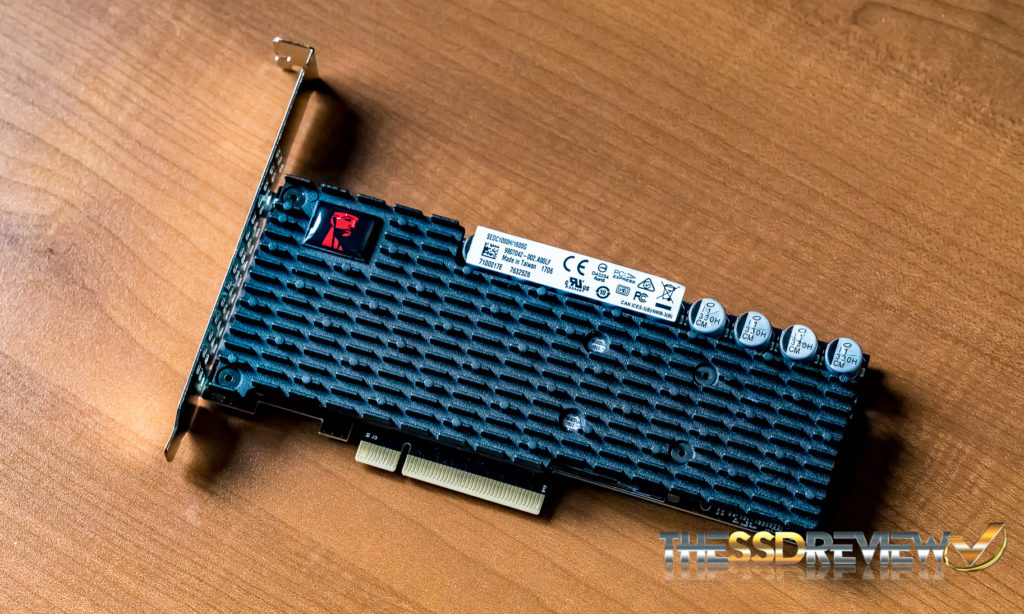It wasn’t too long ago that Kingston announced their newest DCP1000 enterprise NVMe SSD, in teaming up with Liqid, with incredible claims of 6.8GB/s performance and 1.25 million IOPS from a single device. This HHHL AIC speaks of ultra low transactional latency, along with ultra-high throughput, making it the ideal choice for data centers looking for extreme performance. Thanks to Kingston, we just may be the first to have one ‘in-hand’ and it is being put through the rigors with Sean Webster in his enterprise testing regime, as of the date of this report.
Having it hand for a few days before sending it to Sean, we couldn’t resist playing with the DCP1000 for just a bit, ripping it apart to see what it was made of, and getting a few tests in. After all, we are speaking of what just might be the first AIC Card in the world to push just under 7GB/s and over 1 million IOPS in such a small form factor.
SPECIFICATIONS
The Kingston DCP1000 is a PCIe x8 NVMe SSD and is available in capacities of 800MB, 1.6TB, and 3.2TB. Our sample is 1.6TB. It is built to be very plug and play, using native NVMe drivers and has UEFI boot support. Plugging it into my Test Bench was no different than any other card, but for the four volumes that appeared which we will get to.
Performance varies for each capacity, 6.8GB/s read and 5GB/s write with 900K/145K IOPS for the 800MB, 6.8GB/s read and 6GB/s write with 1.1mil/200k IOPS for the 1.6TB and 6.8GB/s read and 6GB/s write and 1 mil/180K IOPS for the 3.2TB version. Active power consumption is a whopping 35W and it has PLP, an MTBF of 2mil hours and a limited 5-year warranty.
COMPOSITION
The Kingston DCP1000 is comprised of four Kingston 400GB PCIe 3 NVMe 4 lane M.2 SSDs run through a PLX Technology PEX8725 24-lane, 10-port PCIe 3.0 switch to the cards PCIe 3.0 x8 connector.
Each SSD is powered by the PhisonPS5007-11 eight channel quad-core controller and each SSD also contains eight modules of Toshiba 15nm mlc NAND flash memory (TH58TF69DFLBA8C) along with a Kingston branded DRAM cache chip.
This specific 400GB M.2 NVMe SSD is not listed at Kingston but we have tested it, the results of which follow in the report.
 The SSD Review The Worlds Dedicated SSD Education and Review Resource |
The SSD Review The Worlds Dedicated SSD Education and Review Resource | 


As expected, the Kingston DCP1000 is an absurdly powerful PCI-e SSD, especially when it comes to Real World File Transfers. It’s only caveat for me, being that all 4 M.2 SSD’s cannot be configured as a boot volume.
Yes… but imagine going the 1/3 route where the first SSD is still pushing over 2GB/s while the remaining three have to be reaching above 5GB/s. I should have tested this specifically but never had the idea until it was shipped off for our enterprise testing.
Les, maybe if you had an Intel DC P3700 on hand, you could’ve done some File Copy tests with the Kingston DCP1000
Yes that would have been possible but comparing any similar enterprise storage resource in a simple file transfer test isn’t really a fair proposition. It is like putting it beside the P4800x and forming opinion on file transfer where the DCP1000 would destroy the P4800…. until of course they are put side by side in true server settings and that P4800 has no settling whatsoever for steadystate.
You’re linking to an old AS SSD https://www.guru3d.com/files-details/as-ssd-benchmark.html is the new one idk about the other softwares you’re linking to!
I’d be curious how the PCIe host card performed with several other M.2 drives installed. This would be a quick and dirty way to get four Samsung 960 Pro’s into a system.
Also curious how it would have handled a single 4x PCIe 3.0 based M.2 drive when put into an older system with an 8x PCIe 2.0 slot. That’d be one way to provide more bandwidth to an older system.